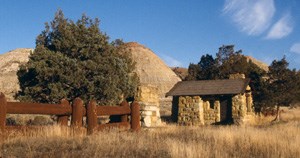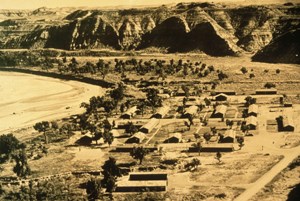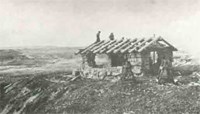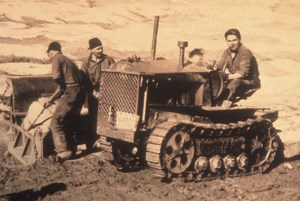
NPS Photo IntroductionThe Civilian Conservation Corps (CCC), established by Congress on March 31, 1933, provided jobs for young, unemployed men during the Great Depression. Over its 9-year lifespan, the CCC employed about 3 million men nationwide. The CCC made valuable contributions to forest management, flood control, conservation projects, and the development of state and national parks, forests, and historic sites. In return, the men received the benefits of education and training, a small paycheck, and the dignity of honest work. Three CCC companies operated in the North Dakota badlands between 1934 and 1941, contributing to projects that today’s visitors can still appreciate. 
NPS Companies and CampsThe North Dakota State Historical Society sponsored the three CCC companies that worked in the badlands from 1934 to 1941. All three CCC companies in the badlands arrived in 1934. About 200 men were assigned to each company. When CCC Companies 2767, 2771, and 2772 arrived, the men lived in tents until buildings could be erected at their camps. When completed, each camp included a full complement of buildings: barracks, mess hall, recreational hall, bath house, latrine, supply, garage, and headquarters. The camp complex also included its own classrooms, hospital, barber shop, post office, canteen, and sometimes a theater. The buildings were frame structures heated by wood and coal burning pot-belly stoves. Company 2767’s camp was located on the west bank of the Little Missouri River in what is now the South Unit of Theodore Roosevelt National Park from July, 1934 to 1937. Companies 2771 and 2772 established camps adjacent to one another in 1934 on the north bank of the Little Missouri River near what is now the entrance to the North Unit of Theodore Roosevelt National Park. Company 2771 moved out in 1935, but Company 2772 remained until the fall of 1939. In 1939, Company 2771 moved to a site on the east bank of the Little Missouri River just south of Jones Creek, which they occupied until November, 1941. 
NPS The WorkThe CCC sought to provide the maximum opportunity for labor at a minimum cost for materials and equipment. With little more than strong backs, shovels, and picks, the CCC built roads, trails, culverts, and structures. When building structures, the CCC utilized native materials, such as the local sandstone, which they quarried themselves with star drills, sledge hammers, muscle, and sweat. In the badlands, the CCC, along with the Emergency Relief Administration (ERA) and the Works Progress Administration (WPA), worked on numerous projects. Even as the men were working on these construction projects, it was unclear who would ultimately be responsible for managing these recreation areas; Theodore Roosevelt National Memorial Park was not established until 1947. In the North Unit of the park, the CCC built the two picnic shelters in the Juniper campground area and the River Bend Overlook shelter. In the South Unit, the CCC built the now-abandoned East Entrance Station, the entrance pylons, and portions of the park's roads and trails. The CCC also built structures at the nearby Chateau de Mores State Historic Site. 
NPS The PeopleThe CCC was open to unemployed men ages 17 to 23.5 who were U.S. citizens. Enrollees served 6-month terms, and were allowed to re-enroll at the end of each term up to a maximum of two years. A CCC worker’s salary was $30 a month, most of which the men sent home to their families. Meals, lodging, clothing, medical, and dental care were all free for enrollees. The men generally spent $5 to $8 of their monthly salary on toiletries, postage, haircuts, and occasional entertainment. The few enrollees promoted to Assistant Leader and Leader positions earned a bit more, $36 and $45 per month, respectively. While the CCC men lived and worked on a regimented schedule, there was time for continuing their education through evening classes and for leisure activities on Saturday afternoons and Sundays. Living and working together, the men learned to get along. Some formed life-long friendships. As the generation who participated in the CCC passes, the legacy of their work lives on. When you visit Theodore Roosevelt National Park and drive the roads, stop at the River Bend Overlook, or hike out to the old East Entrance Station. Take a few moments to reflect on the CCC, the men who labored on these projects, and the investment America made during its most desperate economic period. The Civilian Conservation Corps' hard work all those years ago still continues to pay off today. |
An official website of the United States government
Here's how you know
Official websites use .gov
A
.gov website belongs to an official government
organization in the United States.
Secure .gov websites use HTTPS
A
lock (
) or https:// means you've safely connected to
the .gov website. Share sensitive information only on official,
secure websites.
